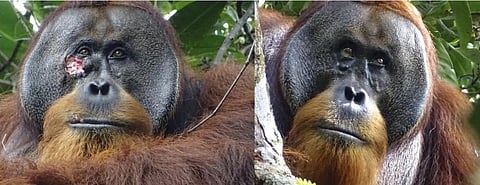

A male orangutan, on the Indonesian island of Sumatra, has been recorded on video by German and Indonesian scientists using a medicinal plant to treat a wound on his face.
The individual — named ‘Rakus’ — resides in Suaq Balimbing, a protected rainforest area home to approximately 150 critically endangered Sumatran orangutans.
Cognitive and evolutionary biologists from the Max Planck Institute of Animal Behavior (MPI-AB) in Konstanz, Germany and Universitas Nasional, Indonesia conducted a study. It was led by Caroline Schuppli and Isabelle Laumer.
“During daily observations of the orangutans, we noticed that a male named Rakus had sustained a facial wound, most likely during a fight with a neighbouring male,” Isabelle Laumer, first author of the study, said in a statement by MPI-AB.
“Three days after the injury Rakus selectively ripped off leaves of a liana with the common name Akar Kuning (Fibraurea tinctoria), chewed on them, and then repeatedly applied the resulting juice precisely onto the facial wound for several minutes. As a last step, he fully covered the wound with the chewed leaves,” the statement noted.
According to Laumer, the plant used by Rakus as a poultice is found in the tropical forests of Southeast Asia. It and other related plants are known for their analgesic and antipyretic effects. They are, in fact, used by local people in traditional medicine to treat various diseases, such as malaria.
“Analyses of plant chemical compounds show the presence of furanoditerpenoids and protoberberine alkaloids, which are known to have antibacterial, anti-inflammatory, anti-fungal, antioxidant, and other biological activities of relevance to wound healing,” added Laumer.
Five days after Rakus tended to himself, his wound healed. Not just that, he also rested more than usual when being wounded. “Sleep positively affects wound healing as growth hormone release, protein synthesis and cell division are increased during sleep,” according to Laumer.
It is not that self-medication has not been observed in non-human species earlier. “The closest relatives to humans, the great apes, are known to ingest specific plants to treat parasite infection and to rub plant material on their skin to treat sore muscles. Recently a chimpanzee group in Gabon was observed applying insects to wounds,” the MPI-AB noted.
However, the treatment of a wound with a biologically active substance has so far not been documented.
Read
According to Laumer, Rakus’ behaviour in this case appeared to be intentional. This is because he selectively treated his facial wound with the plant juice.
“The behaviour was also repeated several times, not only with the plant juice but also later with more solid plant material until the wound was fully covered. The entire process took a considerable amount of time,” said Laumer.
“Since the behaviour has not been observed before, it may be that wound treatment with Fibraurea tinctoria has so far been absent in the behavioural repertoire of the Suaq orangutan population,” the statement noted.
According to Schuppli, Rakus’ place of origin is not known since male orangutans usually leave their natal area after reaching puberty and establish new home ranges.
Orangutans (‘Man of the forest’ in Malay) are one of the extant species of great apes. The others are the Common Chimpanzee, Gorilla and the Gracile Chimpanzee or Bonobo.
The flame-coloured orangutans are found on the islands of Sumatra in Indonesia and Borneo, which is divided between Malayasia, Indonesia and Brunei.
There are three types of orangutans taxonomically — the Sumatran, the Bornean and the Tapanuli.
Rakus’ behaviour shows that medical wound treatment may have arisen in a common ancestor shared by humans and orangutans, the scientists hypothesised.
The earliest mention of humans cleaning, plastering, and bandaging wounds with certain wound care substances is found in a medical manuscript that dates back to 2200 Before Common Era.
“This possibly innovative behaviour (by Rakus) presents the first report of active wound management with a biological active substance in a great ape species and provides new insights into the existence of self-medication in our closest relatives and in the evolutionary origins of wound medication more broadly,” said Schuppli.
She added that “As forms of active wound treatment are not just human, but can also be found in both African and Asian great apes, it is possible that there exists a common underlying mechanism for the recognition and application of substances with medical or functional properties to wounds and that our last common ancestor already showed similar forms of ointment behaviour.”
Active self-treatment of a facial wound with a biologically active plant by a male Sumatran orangutan was published in Scientific Reports on May 2, 2024.